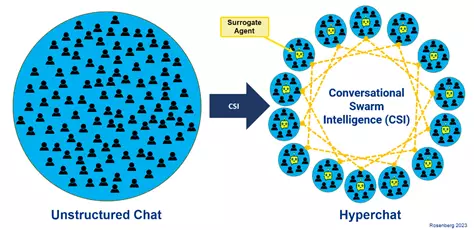Engaging large groups in meaningful discourse has long posed challenges in collaborative environments. Traditional group dynamics dictate that the optimal conversation occurs among small clusters, typically consisting of four to seven participants. As group size escalates, effective communication tends to deteriorate, leading to long pauses and fragmented exchanges. Enter hyperchat: a pioneering technology that leverages artificial intelligence to facilitate real-time dialogue among any number of contributors while ensuring an organized flow of ideas.
The conception behind hyperchat is simple yet profound: if we can channel the cognitive resources of large gatherings of individuals—like sports fans passionate about a topic—we can significantly amplify the productiveness of collaborative discussions and decision-making processes. What stands in the way of this transformation is the recognizable chaos that ensues with increased numbers in a conversation. Hyperchat seeks not only to circumvent this chaos but to redefine how we perceive collective intelligence.
From Chaos to Harmony: How Hyperchat Works
The crux of hyperchat lies in its unique architecture. Instead of attempting to foster a single conversation among hundreds, it partitioned participants into manageable subgroups. Within these units, AI-driven “conversational surrogates” act as facilitators, extracting insights from human interactions and synthesizing those conclusions to share across the broader assembly. This modified approach allows for an intricate weaving of conversations, converting what would traditionally be a cacophony into a harmonious exchange of ideas.
This is similar to the dynamics witnessed in successful brainstorming sessions. By creating a framework that supports parallel and synchronous discussions, hyperchat offers a solution that does not just enhance communication among large assemblies but actually harnesses their collective cognitive power to forge better decisions and creative solutions. With this technology’s first major test case, the results have proven unexpectedly promising.
Case Study: The March Madness Experiment
In a groundbreaking experiment conducted on the Thinkscape platform, 50 sports enthusiasts were tasked with collaboratively generating a March Madness bracket. While one might assume that aligning the opinions of such a sizable group would lead to a disconnected and disjointed outcome, the results contradicted these expectations. The bracket produced has ranked within the top 1.4 percent of all entries in the ESPN March Madness contest, a testament to the potential unlocked by hyperchat.
But beyond success measured numerically lies a deeper narrative pertaining to the psychological experience of participants. Conceiving a winning bracket under the pressure and uncertainty of a sports tournament required not only strategic thought but seamless collaboration. The group achieved this organically through hyperchat, thereby showcasing the platform’s capability to synchronize diverse viewpoints into a coherent and optimized proposition in substantially less time than traditional methods would allow.
Measuring the Intelligence of the Crowd
Compelling statistics from the ongoing exploration of hyperchat have illuminated its embedded strengths. In separate trials where participants engaged with standard forms of communication versus hyperchat, those utilizing the latter reported feeling markedly more fulfilled and effective in their collaborative efforts. Groups averaged a combined IQ score that surpassed individual benchmarks, moving from a 100 to an impressive 128 when working in the hyperchat model. This leap illustrates a poignant truth: the collective often outperforms any one individual within it when the right structures are in place.
Furthermore, the appeal of hyperchat goes beyond mere efficiency. Empirical evidence indicates that participants not only enjoy the process more—they feel a sense of ownership and commitment toward the final outcomes produced. This emotional investment is particularly vital in a corporate structure where employee buy-in can significantly affect the success of projects and initiatives.
The Future of Collaborative Intelligence
Looking towards the future, it’s clear that the marriage of artificial intelligence with human intellect can yield extraordinary advancements. Hyperchat technology allows for hybrid teams composed of both human participants and AI contributors to make optimized decisions while maintaining a human oversight framework. As companies continue to expand, the necessity for agile and productive collaboration will only intensify.
Hyperchat represents a significant stride toward solving long-standing hurdles of communication, particularly within organizations that employ thousands of individuals. Imagine an entire corporation leveraging this technology for real-time insights during product launches, crisis management, or strategic planning sessions. The implications of hyperchat as a tool for collective intelligence are boundless and may very well redefine collaboration in contemporary workplaces.
As we observe the unfolding events of March Madness, one thing becomes abundantly clear: hyperchat isn’t merely a fleeting technological gimmick; it’s a powerful transformation that could alter our approach to teamwork for generations to come.

